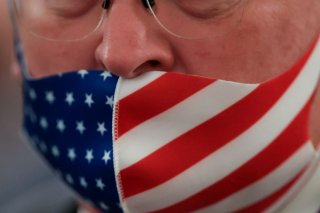Study Says “Half-Masking” Increases Risk of Coronavirus Infection
Don't constantly touch your face or your mask.
“Half-masking,” or wearing of a face mask below the nose, likely makes an individual more susceptible to contracting the novel coronavirus, a recent study out of the University of North Carolina (UNC) has confirmed.
The study’s findings, which were published in the journal Cell, suggest that SARS-CoV-2—the virus that causes the coronavirus—tends to initially become firmly established in the nasal cavity, then, in some cases, the virus is aspirated into the lungs where it may lead to a more serious condition, such as potentially fatal pneumonia.
“If the nose is the dominant initial site from which lung infections are seeded, then the widespread use of masks to protect the nasal passages, as well as any therapeutic strategies that reduce virus in the nose, such as nasal irrigation or antiviral nasal sprays, could be beneficial,” the study’s co-senior author Dr. Richard Boucher, director of the Marsico Lung Institute at the UNC School of Medicine, said in a news release.
In one set of laboratory experiments, the researchers used different isolates of SARS-CoV-2 to better understand how efficiently they could infect cultured cells from different parts of the human airway.
They eventually noticed a discernable pattern of continuous variation, or gradient, from a relatively high infectivity of the coronavirus in cells lining the nasal passages to less infectivity in cells lining the throat and bronchia.
The researchers also discovered that ACE2—the cell-surface receptor that the coronavirus uses to enter cells—was more abundant on nasal-lining cells compared to cells in the lower airway.
This difference could explain why nasal-lining cells are more susceptible to coronavirus infections.
“These results, using some novel and innovative methodology, open new directions for future studies on SARS-CoV-2 that may guide therapeutic development and practices for reducing transmission and severity of COVID-19,” James Kiley, director of the Division of Lung Diseases at the National Heart, Lung, and Blood Institute, said in a release.
In other cases, how one wears a mask doesn’t matter if the type of material used doesn’t meet certain standards.
According to a recent study conducted by Duke University, the researchers found that not all face masks and coverings are equally effective in curbing the spread of coronavirus.
After testing fourteen common face masks and coverings, the team discovered that neck gaiters—tubes of performance fabric generally used for running and exercising outdoors—offered basically zero protection against the contagion and even had the potential to spread the virus further.
“We attribute this to … the textile breaking up those big particles into many little particles,” the study’s author Dr. Martin Fischer said in a video release. “They tend to hang around longer in the air, they can get carried away easier in the air, so this might actually be counterproductive to wear such a mask.”
N95 respirators with no valves garnered the highest score in the study, but experts have noted that these devices are in short supply nationwide and should be reserved for frontline healthcare workers.
There are now more than 24.3 million confirmed cases of coronavirus worldwide, including at least 828,000 deaths, according to the latest data from Johns Hopkins University.
Ethen Kim Lieser is a Minneapolis-based Science and Tech Editor who has held posts at Google, The Korea Herald, Lincoln Journal Star, AsianWeek and Arirang TV. Follow or contact him on LinkedIn.
Image: Reuters

